Hard News: The War Stories
32 Responses
First ←Older Page 1 2 Newer→ Last
-
And on Jim Mora's radio show this avo . Shirley Murray a NZ hymn writer on her Anzac hymn . The controversial third verse is being omitted by many.
Honour the brave whose conscience was their call,
answered no bugle, went against the wall,
suffered in prisons of contempt and shame,
branded as cowards, in our country's name.The conscientious objectors , like James K's father Archibald Baxter who were seen as cowards .
Not a cool thing to note I know, in the midst of honoring the brave, but when I look at damage that 6 years of being a solder did to my father. I cannot help but reflect on the inhuman result of war.
Not all wars were noble ones .
And yes those poor bastards who went to fight for ideals and to protect those at home , they too have my deep respect and my grieving.
-
Anzac Day just makes me sad and I've never felt moved to join a dawn parade and stand around with people who generally think war is either honourable or at least unavoidable. Call me an idealist but I'm with the conscientious objectors. Didn't stop me from taking my son to see 'Lawrence of Arabia' in glorious 4K last Sunday though...
-
I have taken my son since he inherited his Koro's medals. It's nothing to do with glorifying war, it's about honouring the effort and loss made by a couple of generations.
-
The particular devastation of the world wars on Maori can't be underestimated. I don't know, but would not be surprised to learn, that they are a high proportion of the armed forces today.
-

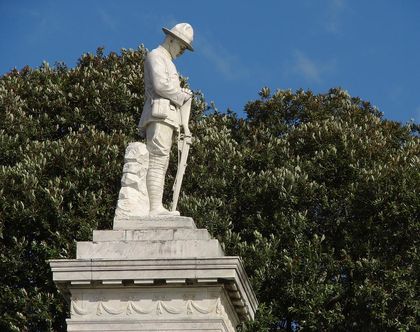
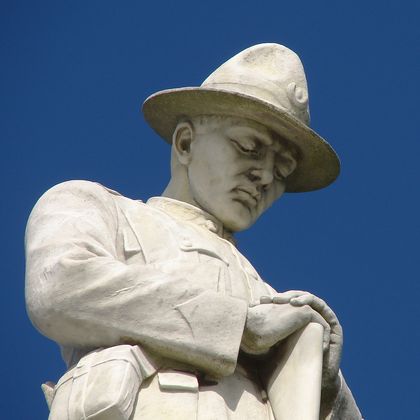
My preparation today for Anzac Day involved visiting the Gisborne district war memorial cenotaph to photograph it complete with its marble soldier on top. The monument was damaged in the December 2007 earthquake. Subsequent investigations indicate it is in poor structural condition on weak foundations close to the riverbank. The soldier is to be removed immediately after Anzac Day for safe-keeping, associated with a decision to restore and rebuild the monument more robustly at major expense.
“The Sorrow and the Pride” expressed in marble and bronze in the early 1920s – the dislocation of the column not to be ignored.
No hint of glory in this soldier. The pohutukawa leaves turn up in a fresh breeze to complement the marble.
That marble soldier seems thoroughly expressive. I’ve never seen this with clarity before, so high out of reach of the naked eye view – unfortunately so.
-
Hebe, in reply to
That marble soldier seems thoroughly expressive.
And young, so young,
-
Chris Waugh, in reply to
And young, so young,
I've been doing my usual Anzac Day lesson this week. It's a certain kind of magic to tell my students that those soldiers were their own age when they lost their lives and see - physically see the expressions on their faces and the lights in their eyes - that little statement sink in.
Speaking of... ChrisW, either that is a 19 year old veteran pretending to be marble, or the sculptor was a magician of the highest order. Particularly in your close-up of his face, I see life, love, relief, mourning, pride, regret, and all to a degree that one should not be able to see in a child so young. I must get back to Gisborne one of these days; remind me to look up that statue and pay my respects when I do.
-
Really good to see Kay and Annie's doco just now - always a pleasure seeing Jake Bryant's camerawork too. I have huge respect for Jon Stephenson and it was fascinating seeing him at work in the field. Maybe our army should only be used for national emergencies and actual overseas aid and reconstruction projects - a truly pacifist force...
-
Russell Brown, in reply to
The particular devastation of the world wars on Maori can’t be underestimated. I don’t know, but would not be surprised to learn, that they are a high proportion of the armed forces today.
Yes, that's absolutely the case.
-
ChrisW, in reply to
I must get back to Gisborne one of these days; remind me to look up that statue and pay my respects when I do.
Please do - but he won't be back for a year or two yet. I suspect the centenary of Anzac Day itself in 2015 will be a more realistic schedule than next year.
-
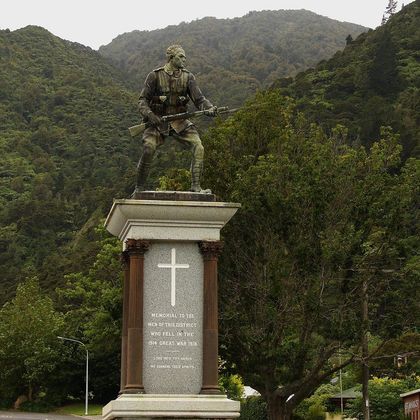
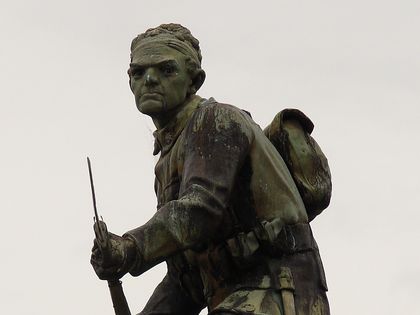
Compared with that marble soldier, the Te Aroha WWI memorial in bronze, grey granite and cast iron takes a very different stance! The aggression seems dissonant with the inscription “Lord into thy hands we commend their spirits”.
No sign of prideful sorrow here.
Could it have been a “boy named Sue” effect relating to a town named “The Love”? Nevertheless it’s real cultural history in itself and looks remarkable against the bush slopes of Te Aroha mountain. Another photo of its town context in the record store/music thread.
-
linger, in reply to
The aggression seems dissonant with the inscription “Lord into thy hands we commend their spirits”.
… indeed: presumably the inscription is supposed to refer to the list of the fallen, but really the only way of reconciling the verbal and visual messages is to read “their” as referring to “those we killed” (cf. Patton’s comment that war “isn’t about dying for your country, it’s about making the other poor bastard die for theirs”). And, well, yeah, we should remember also that there are other fallen than our own.
-
BenWilson, in reply to
The particular devastation of the world wars on Maori can't be underestimated. I don't know, but would not be surprised to learn, that they are a high proportion of the armed forces today.
They are. Somewhere around 20%. Interestingly, Maori women are even more represented, as a proportion of the female armed forces, over 25%. The overall proportion of women is still quite low, though, less than 20% of the army are women.
Just a pedantic thing here, but it's better to say they "shouldn't be underestimated" rather than that they "can't be underestimated". The latter phrasing implies they are zero.
-
This is good news: He Toki Huna: New Zealand In Afghanistan is available for viewing on-demand.
-
-
And we don't just remember the soldiers. My great-great aunt Marion Brown, of Southland, died when the Marquette was torpedoed.
http://muse.aucklandmuseum.com/databases/Cenotaph/1781.detailA little more detail here:
http://www.rootsweb.ancestry.com/~nzlscant/marquette.htm -
Graeme Edgeler, in reply to
They are. Somewhere around 20%.
At the 2006 census, the proportion of people aged 20-29 who gave a clear answer to the Maori descent question and who indicated they were of Maori descent was over 20%.
-
Graeme Edgeler, in reply to
The conscientious objectors , like James K’s father Archibald Baxter who were seen as cowards .
This article from the VUW Student Magazine Salient had a pretty big effect on me when I first read it.
-
BenWilson, in reply to
The mean age for army personnel at that time was around 29.5 according to this study. So I think comparing to the general population, rather than just the 20-29 year old population, is relevant. Although that is quite an interesting stat.
-
-
Islander, in reply to
And the blokes who fought in the desert campaigns-
one of the utterly inglorious things about the WW1 campaign is what happened to the horses.
My blown-to-bits greatuncle Peter took his horse to war. Neither of them came back.
Bad enough BUT
-there was - I understand - a deliberate decision, made on financial grounds, not to repatriate ANZ horses-
hate pollies?
O Yes! I do! -
According to this story Bess came back.
-
Islander, in reply to
Yes, indeedy.
Out of the 10,000 plus who went overseas, only (only!) half of which were estimated
to have been killed on battlefields.
Peter's horse is still remembered in the whanau (as well as Peter of course!) because he was unusually intelligent & well-trained. -
My Gallipoli bound Granddad, just before he left Middle East, along with practically the whole Canterbury Mounteds, took their horses down to the beach and shot them. He said it was because they would not leave them for the locals as they treated theirs appallingly. They couldn't bear seeing theirs treated the same way.
He managed to get back with a bullet grooved skull and a piece of metal inserted to cover the wound.
-
Kyle Matthews, in reply to
-there was - I understand - a deliberate decision, made on financial grounds, not to repatriate ANZ horses-
Also quarantine reasons. According to wikipedia, 136,000 horses were shipped from Australia. 13,000 were left at the end of the war, only one returned to Australia, the rest were killed or went to India.





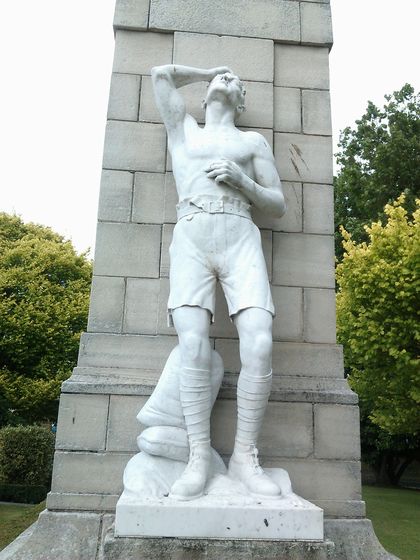
Post your response…
This topic is closed.